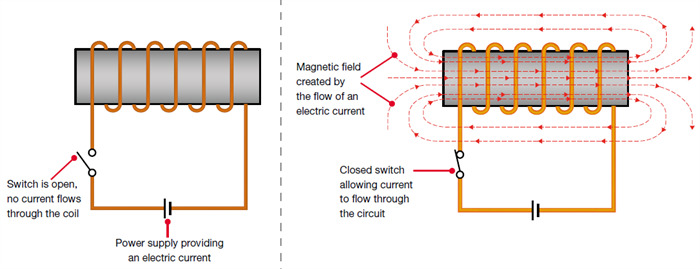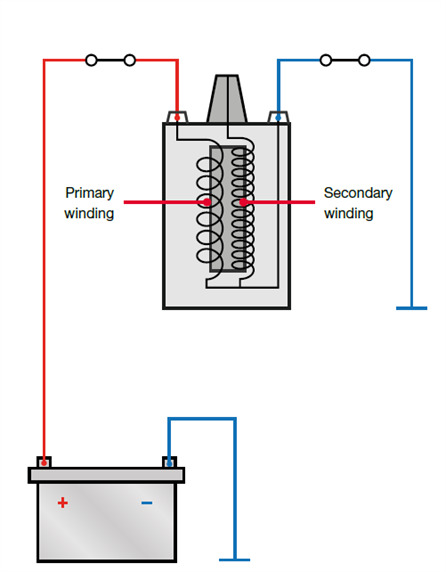Back to basics: How an ignition coil works

The history of ignition coils
Although ignition systems have certainly evolved over time – in particular incorporating more and more electronics – they still bear the hallmarks of the original coil ignition systems that were introduced more than 100 years ago.
The first coil-based ignition system is credited to the American inventor Charles Kettering, who developed a coil ignition system for a major vehicle manufacturer around 1910/1911. For the first time, he devised an electrical system that powered the starter motor and ignition at the same time. The battery, a generator and a more complete vehicle electrical system provided a relatively stable electrical supply to the ignition coil.
The Kettering system (Figure 1) used a single ignition coil to produce a high voltage, which was passed to a rotor arm that effectively pointed the voltage to a series of electrical contacts located in the distributor assembly (one contact for each cylinder). These contacts were then connected by spark plug wires to the spark plugs in a sequence that made it possible to distribute the high voltage to the spark plugs in the correct cylinder firing order.

Figure 1: The main components of a Kettering ignition system
The Kettering ignition system became virtually the only type of ignition system for mass-produced petrol cars, and stayed that way until electronically switched and controlled ignition systems started to replace mechanical ignition systems during the 1970s and 1980s.
The basic principle of an ignition coil
To produce the required high voltages, ignition coils make use of the relationships that exist between electricity and magnetism.
When an electric current flows through an electrical conductor such as a coil of wire, it creates a magnetic field around the coil (Figure 2). The magnetic field (or, more precisely, magnetic flux) is effectively a store of energy, which can then be converted back into electricity.

Figure 2: Creating a magnetic field by flowing electric current through a coil
When the electric current is initially switched on, the current flow rapidly increases to its maximum value. Simultaneously, the magnetic field or flux will progressively grow to its maximum strength, and will become stable when the electric current is stable. When the electric current is then switched off, the magnetic field will collapse back in towards the coil of wire.
There are two main factors that affect the strength of the magnetic field:
1) Increasing the current being applied to the coil of wire strengthens the magnetic field
2) The higher number of windings in the coil, the stronger the magnetic field.
Using a changing magnetic field to induce an electric current
If a coil of wire is exposed to a magnetic field and the magnetic field then changes (or moves), it creates an electric current in the coil of wire. This process is known as ‘inductance’.
This can be demonstrated simply by moving a permanent magnet across a coil. The movement or change in the magnetic field or magnetic flux induces an electric current into the coil wire (Figure 3).
 Figure 3: A changing or moving magnetic field induces an electric current in a coil
Figure 3: A changing or moving magnetic field induces an electric current in a coil
There are two main factors that affect how much voltage is induced into the coil:
- The faster the change (or speed of movement) of the magnetic field and the greater the change in the strength of the magnetic field, the greater the induced voltage.
- The greater the number of windings in the coil, the greater the induced voltage.
Using a collapsing magnetic field to induce an electric current
When a magnetic field has been created by applying an electric current to a coil of wire, any change in the electric current (increase or decrease in current flow) creates the same change in the magnetic field. If the electric current is switched off, the magnetic field will collapse. The collapsing magnetic field will then induce an electric current into the coil (Figure 4).  Figure 4: If an electric current used to create a magnetic field is switched off, the magnetic field collapses, which induces another electric current into the coil
Figure 4: If an electric current used to create a magnetic field is switched off, the magnetic field collapses, which induces another electric current into the coil
In the same way that increasing the speed of movement of a magnetic field across a coil of wire will increase the voltage induced into the coil, if a collapsing magnetic field can be made to collapse more rapidly, this will induce a higher voltage. Additionally, a higher voltage can also be induced into the coil if the number of windings in the coil is increased.
Mutual inductance and transformer action
If two coils of wire are placed next to or around each other and an electric current is used to create a magnetic field around one coil (which we call the primary winding), the magnetic field will also surround the second coil (or secondary winding). When the electric current is switched off and the magnetic field then collapses, it will induce a voltage into both the primary and the secondary windings. This is known as ‘mutual inductance’ (Figure 5).

Figure 5: The magnetic field in the primary winding also surrounds the secondary winding. Collapsing the field induces electric currents in both windings
For ignition coils (and many types of electrical transformer), the secondary winding is made with more windings than the primary winding. When the magnetic field collapses, it will therefore induce a higher voltage into the secondary winding than into the primary winding (Figure 6).

Figure 6: Here, the secondary winding has more coils than the primary winding. When the magnetic field collapses, the voltage in the secondary coil will be greater than the voltage induced in the primary winding
The primary winding of an ignition coil will typically contain 150 to 300 turns of wire; the secondary winding will typically contain 15,000 to 30,000 turns of wire, or around 100 times more than the primary winding.
The magnetic field is initially created when the vehicle’s electrical system applies approximately 12 volts to the ignition coil’s primary winding. When a spark is required at a spark plug, the ignition system will switch off the current flow to the primary winding, which will cause the magnetic field to collapse. The collapsing magnetic field will induce a voltage into the primary winding in the region of 200 volts; but the voltage induced into the secondary winding will be approximately 100 times greater, around 20,000 volts.
By using the effects of mutual inductance and by using a secondary winding that has 100 times more windings than the primary winding, it is therefore possible to transform the original 12-volt supply into a very high voltage. This process of changing a low voltage into a high voltage is referred to as the ‘transformer action’.
In an ignition coil, the primary and secondary windings are wrapped around an iron core, which helps concentrate and enhance the strength of the magnetic field and flux, thus making the ignition coil more efficient.
DENSO is a long-standing leader in direct ignition technology, and DENSO’s ignition coils are available to the aftermarket. Find out more about the types of DENSO Ignition Coil and their benefits.




















































